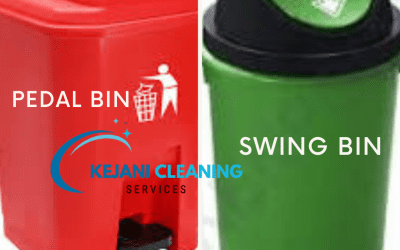Waste disposal is a crucial part of hygiene, whether in homes, offices, schools, hospitals, or public spaces. One of the most commonly used waste bins in Kenya is the swing bin—a simple, practical design where the lid swings open and then returns to its closed position. But not all swing bins are created equal.
At Kejani Cleaning Services Limited, we help clients choose the right bin based on functionality, durability, aesthetics, and purpose. In this post, we break down the different types of swing bins available by material, color, shape, size, and ideal use cases.
1. Types of Swing Bins by Material
🧴 Plastic Swing Bins
-
Most common and cost-effective
-
Made from polypropylene (PP) or HDPE plastic
-
Lightweight and easy to clean
-
Ideal for homes, offices, and schools
-
Available in various colors and sizes
Pros:
-
Affordable
-
Rust-proof
-
Easy to sanitize
Cons:
-
Less durable under heavy use
-
Can crack under high impact or heat
🪙 Metal Swing Bins
-
Typically made from stainless steel or powder-coated steel
-
Sleek and modern finish
-
Ideal for hotels, corporate offices, and upscale spaces
Pros:
-
Durable and corrosion-resistant
-
Visually appealing
-
Fire-resistant
Cons:
-
Heavier and costlier than plastic
-
Prone to fingerprints and smudges
🧺 Wooden/Decorative Swing Bins
-
Usually used in designer interiors
-
Wood or faux-wood finish combined with a plastic liner
Pros:
-
Aesthetic value
-
Suitable for luxury spaces
Cons:
-
Not suitable for wet waste
-
Harder to sanitize than plastic or steel
2. Types of Swing Bins by Color
Color-coding is increasingly important for waste segregation and hygiene management. Many Kenyan institutions now use colored swing bins for specific waste types.
| Color | Recommended Use |
|---|---|
| Black | General waste |
| Green | Organic/biodegradable waste |
| Yellow | Clinical waste or infectious materials |
| Red | Hazardous waste or sanitary waste |
| Blue | Recyclables like paper and plastic |
| White | Confidential paper waste (offices) |
| Grey | Mixed use in neutral spaces |
Having color-coded swing bins in offices, hospitals, or public areas helps reduce cross-contamination and improves overall hygiene practices.
3. Types of Swing Bins by Shape
🟦 Rectangular Swing Bins
-
Ideal for corners or space-saving layouts
-
Suitable for offices, schools, and kitchens
-
Can sit flush against walls
🟠 Round Swing Bins
-
More aesthetically pleasing in living rooms and open spaces
-
Commonly found in hotels and washrooms
🟢 Oval or Tapered Swing Bins
-
Used in designer settings or as part of decorative interior waste systems
The choice of shape often depends on aesthetics, floor space, and ease of access.
4. Types of Swing Bins by Size
Swing bins come in a wide range of sizes to match specific waste volumes and space availability.
| Capacity | Common Use Case |
|---|---|
| 5L – 10L | Personal desk use, bedrooms, washrooms |
| 15L – 20L | Under-sink kitchen bins |
| 30L – 45L | Offices, classrooms, wash areas |
| 60L – 80L | Shared kitchen spaces, hotel corridors |
| 100L+ | Commercial/public areas, institutions |
When choosing a size, consider:
-
Volume of waste generated
-
Frequency of disposal
-
Number of users
5. Use Cases for Swing Bins in Kenya
🏠 Residential Homes
-
Plastic swing bins are perfect for bedrooms, kitchens, and bathrooms
-
Use color-coded bins in the kitchen for easier waste segregation
🏢 Corporate Offices
-
Install small to medium rectangular swing bins under desks or near printers
-
Use white or blue bins for paper recycling
🏨 Hotels & Lodges
-
Prefer stainless steel swing bins in restrooms and lobbies
-
Coordinate bin color and finish with the interior décor
🏫 Schools & Institutions
-
Use multiple color-coded swing bins in hallways and cafeterias
-
Encourage students to separate recyclables, organic, and general waste
🏥 Hospitals & Clinics
-
Use yellow or red swing bins for medical and infectious waste
-
Choose bins with labels to meet biomedical waste segregation standards
🛍 Shops & Public Spaces
-
Medium to large bins in black or grey work well for general litter
-
Place at entrances, exits, and food courts
6. Advantages of Swing Bins
-
Cost-effective and readily available
-
Easy to use for all age groups
-
Simple to clean and maintain
-
Lightweight and portable
-
Suitable for both indoor and outdoor use with the right material
7. Limitations of Swing Bins
-
Require hand contact to open—less hygienic than pedal bins
-
May spill if overfilled
-
Swing lids can loosen over time if frequently misused
For hygiene-critical areas like hospitals and kitchens, pedal bins or sensor bins may be a better option.
8. Best Practices When Using Swing Bins
-
Line bins with garbage bags for easier disposal and cleanliness
-
Avoid overfilling to ensure the lid closes properly
-
Clean and disinfect regularly—especially shared bins
-
Label bins clearly if used for waste segregation
Where to Buy Swing Bins in Kenya
At Kejani Cleaning Services Limited, we stock a wide variety of swing bins in different:
-
Sizes: from 5L to 100L+
-
Materials: plastic and stainless steel
-
Colors: for medical, residential, and office use
-
Shapes: round, square, rectangular, and decorative
📦 Shop Swing Bins Now
📞 Need help choosing the right swing bin? Reach out to our customer service team for personalized assistance.
Conclusion
Swing bins remain one of the most affordable and versatile waste disposal solutions in Kenya. With options in material, color, shape, and size, you can find the perfect bin for your specific needs—whether you’re managing household trash, setting up waste segregation in a hospital, or improving office hygiene.
Choosing the right swing bin can make all the difference in keeping your environment clean, organized, and compliant with local waste management standards.




0 Comments